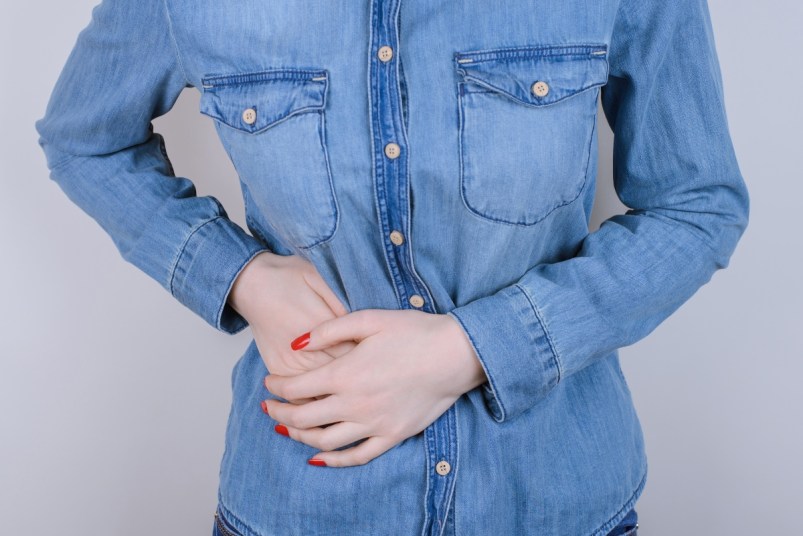Could a Sluggish Gallbladder Be the Cause of Your Bloating and Discomfort? (Here’s How To Fix It)
These tips may help you dodge discomfort and restore your vitality.

Most of us rarely think of our gallbladder — but the small organ plays a big role in digestion. “When we eat fatty foods, the gallbladder squeezes bile into the small intestine to break down the fats,” explains gastroenterologist Peyton Berookim, MD. “But if the gallbladder isn’t releasing enough bile, it can lead to symptoms like bloat, burping, and diarrhea.” For many women with a sluggish gallbladder, the culprit is bile that’s so thick, it hinders the organ’s ability to function, according to women’s health expert Ann Louise Gittleman, PhD. And because bile plays a role in the absorption of fat-soluble vitamins, gallbladder issues may lead to vitamin deficiency and fatigue, Dr. Berookim adds. Women are at highest risk, especially as we age, thanks to the hormone flux that occurs in perimenopause.
Thankfully, a few easy lifestyle tweaks are all it takes to return your sluggish gallbladder to peak health so you can feel your all-time best.
Treat yourself to an elixir.
“Bitters are your gallbladder’s best friend,” says Dr. Gittleman. “These plant tinctures stimulate the release of bile and are best taken before a meal.” A delicious way to get your bitters? Sip Gittleman’s “Metabolixir” mocktail. To make: Mix ¼ cup of water, 1 tablespoon of apple cider vinegar, ¼ teaspoon of bitters (Gittleman likes Urban Moonshine Bitters), ¼ teaspoon of ground ginger, ⅛ teaspoon of cayenne, and 1 drop of stevia. “Just don’t overdo the sweetener — you must be able to taste the bitters for them to stimulate those digestive juices and get your gallbladder contracting,” Gittleman notes. Also smart: Add bitter greens like arugula, watercress, endive, or radicchio to salads or stir-fry dishes. According to Dr. Berookim, “bitter greens help detoxify the liver, leading to higher-quality bile.”
Relax with a warm compress.
What if pampering yourself and your gallbladder were one and the same? They can be, says Gittleman. She advises placing a warm castor oil compress below your belly button a few times a week while you relax. “The compress helps remove toxins via the bile route,” she says. How? Castor oil’s ricinoleic acid detoxifies the gallbladder. And the heat stimulates contraction of the gallbladder to keep it working at peak efficiency, adds Dr. Berookim. To do: Soak a yard of 100 percent wool flannel in castor oil; place in a baking dish. Heat in the oven at 250 Faranheit until warm (about 1 hour). Lie down, rub 3 tablespoons of castor oil on your abdomen. Lay the soaked flannel on top. Cover the flannel with plastic wrap and top with a heating pad for an hour as you read or watch TV.
Get your ‘bounce’ on.
Exercise stimulates the intestines to contract, and that prods the gallbladder to empty and refill — factors crucial to the prevention of gallbladder disease. Indeed, studies have shown exercise can help reduce the risk of gallstones. To spice up your routine, try rebounding, or jumping on a small trampoline. “It improves lymphatic flow and detoxifies the gallbladder,” says Gittleman. To try it, search “rebounder classes” on Google, or download a free app like Mr. Rebounder. Too tired to bounce? Try Gittleman’s Bile Builder supplement with what she calls the “superstar six” gallbladder nutrients: choline, taurine, beet root, pancreatic lipase, ox bile, and Collinsonia root. Find Bile Builder at UniKeyHealth.com.
Another cause of bloating? Intestinal parasites that infect 80% of women. Click through to learn more about how to tell if parasites are the cause of your bloating — and to discover how black walnut and wormwood can eliminate intestinal parasites.
This content is not a substitute for professional medical advice or diagnosis. Always consult your physician before pursuing any treatment plan.
This article originally appeared in our print magazine, First For Women.
















